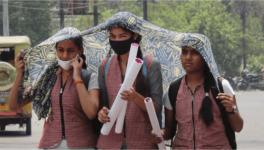India Reported 2nd Highest Deaths Caused by Climate Change in 1970-2021

File Image
Climate change impacts us in ways that escape our usual observation, feeling and attention. Getting an objective analysis of the number of exact deaths, amount of economic loss, number of people becoming homeless, etc. helps in realising the actual impact of the man-made catastrophe.
A World Meteorological Organization (WMO) report titled ‘Status of Mortality and Economic Losses Due to Weather, Climate and Water Extremes (1970-2021)’ shows the global assessment of the impact of extreme weather and climatic conditions. The report was brought out during the quadrennial session of the World Meteorological Congress.
From 1970 to 2021, the report reveals, Asia was the worst sufferer in the number of weather- and climate-related deaths with 3,612 disasters resulting in 9,84,263 deaths (47% globally) and an economic loss of as high as $1.4 trillion (33%).
Notably, India was second in death toll at 1,38,377 with Bangladesh having the highest at 5,20,758. Myanmar with 1,38,666 deaths, caused mainly by the 2008 cyclone Nargis, and China with 88,457 are third and fourth, respectively.
Interestingly, the number of disasters among these Asian countries was highest in China at 740 and second in India at 573. Bangladesh had fewer disasters than India or China at 281.
Africa was the second worst sufferer with 7,33,585 deaths in 1,839 disasters and an economic loss of $43 billion—95% of the reported deaths were attributable to droughts and Somalia had the highest toll at 4,00,000 deaths due to extreme weather.
North America, Central America and the Caribbean combined had 2,107 disasters, second after Asia, causing 77,454 deaths and an economic loss of $2 trillion. Notably, these regions alone shared the highest economic loss globally at 46%. The United States bore a loss of $1.7 trillion during the period.
South America and the Southwest Pacific suffered 58,484 and 6,6951 deaths and economic losses of $115.2 billion and $185.8 billion, respectively. Tropical cyclones caused the highest number of deaths in the Southwest Pacific and floods caused 61% of all the disasters in South America.
On the other hand, Europe reported 1,66,492 deaths with an economic loss of $562 billion in 1,784 disasters. Europe accounted for 8% of the global deaths during the period. The leading cause of death in Europe was extreme temperature, and floods cost the economy dearly.
Developing countries accounted for 71% of the reported disasters, developed countries 24% and economies in transition accounted for 5%.
Again, the developing countries accounted for 91% of the total reported deaths globally while developed countries and economies in transition had their share of 6% and 3%, respectively. The WMO reported that economic losses were greatest in developed countries at 60% while developing countries and economies in transition accounted for 37% and 3% of all the reported losses, respectively.
According to WMO, 37% (7,80,210) of all the reported deaths were caused by tropical cyclones and floods accounted for 45% of all the disasters. The highest number of floods were reported in Asia, accounting for 31% of all flood-related disasters.
The report also shows that mortality in recent times has decreased with the strengthening of the early warning system. The Quadrennial Congress is ramping up efforts to ensure early warning systems for all by 2027.
Get the latest reports & analysis with people's perspective on Protests, movements & deep analytical videos, discussions of the current affairs in your Telegram app. Subscribe to NewsClick's Telegram channel & get Real-Time updates on stories, as they get published on our website.
























